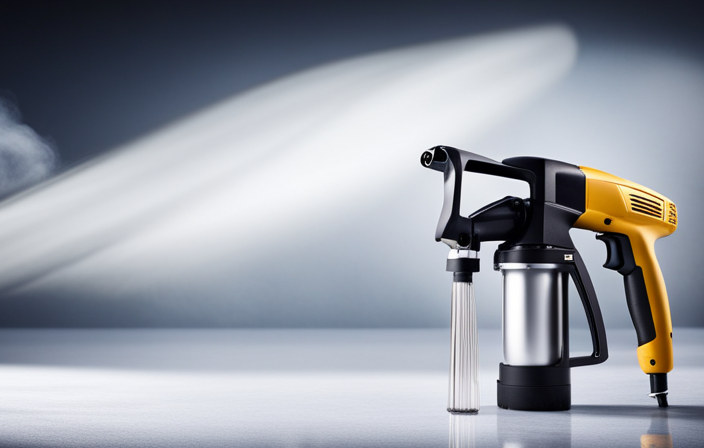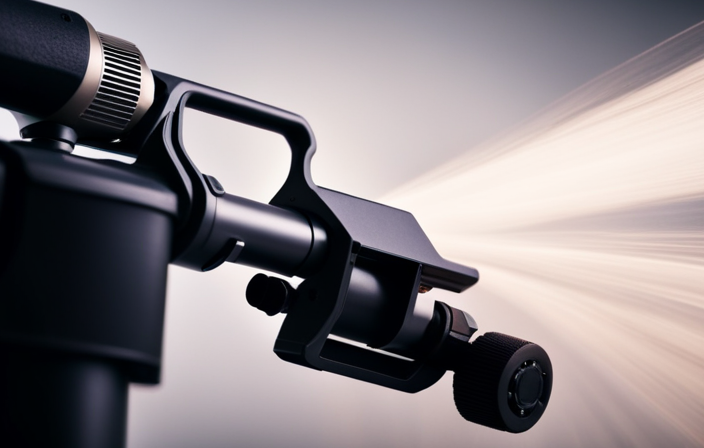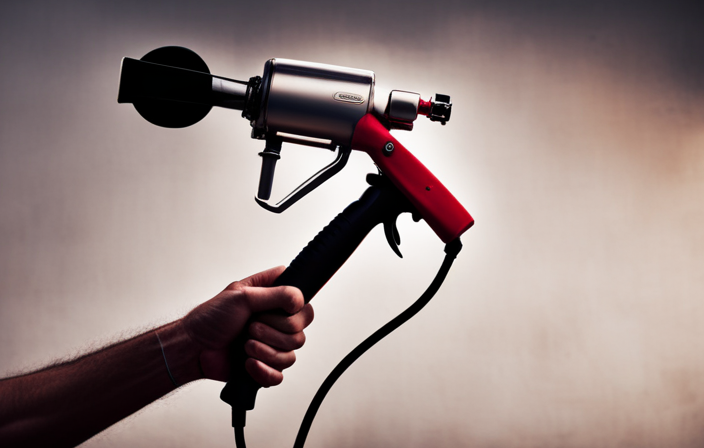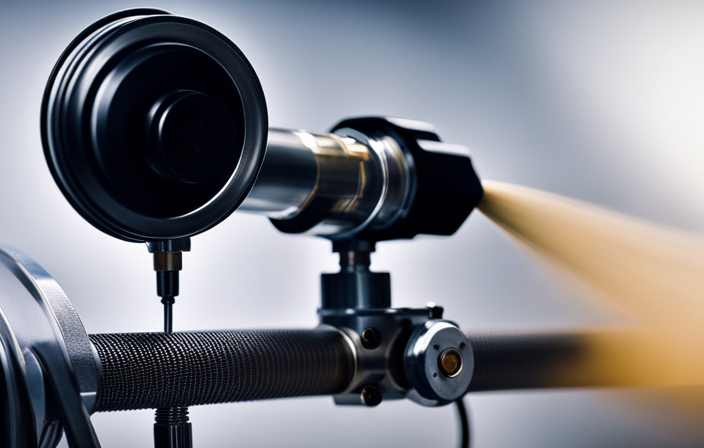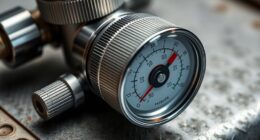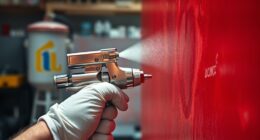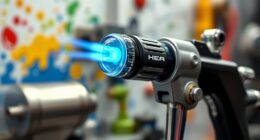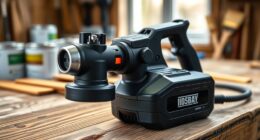Have you recently gotten your hands on an airless paint sprayer? Well, let me share some knowledge with you, buddy – you’re about to step into a whole new world of painting convenience and efficiency. Bid farewell to the tedious chore of using a brush and the uneven finishes that rollers often leave behind. With your airless paint sprayer, you’re all set to achieve smooth, flawless finishes quickly.
But here’s the thing, not all paints are created equal when it comes to airless sprayers. You need to know which ones play well with this magnificent tool. Lucky for you, I’ve done my research and I’m here to spill the beans.
In this article, we’ll dive deep into the world of paints compatible with airless paint sprayers. We’ll explore the likes of:
- Latex paints
- Oil-based paints
- Elastomeric paints
- Acrylic paints
- Enamel paints
- Primers
- Water-based paints
- Exterior paints
- Interior paints
By the end of this read, you’ll be armed with all the knowledge you need to choose the perfect paint for your airless sprayer. So, let’s get painting!
Key Takeaways
- Water-based paints are suitable for use with airless paint sprayers and offer benefits such as environmental friendliness, versatility, excellent adhesion, and durability.
- When choosing exterior paints for airless paint sprayers, it is important to select paints that can withstand the elements, enhance the home’s curb appeal, and consider recommended brands such as Sherwin-Williams, Behr, Benjamin Moore, PPG, and Valspar.
- Interior paints for airless paint sprayers should be chosen based on the desired look and feel of the room, considering factors such as paint sheen options, color choice, natural lighting, room size, and personal preferences.
- The right exterior paint for airless paint sprayers should provide long-lasting protection against the elements, enhance the home’s curb appeal, and consider recommended brands such as Sherwin-Williams, Behr, Benjamin Moore, PPG, and Valspar.
Latex Paints
You can easily load up your airless paint sprayer with latex paints, creating a smooth and even coat of vibrant color that effortlessly glides onto your walls, like a gentle breeze of creativity.
One of the advantages of using latex paints with an airless paint sprayer is that they dry quickly, allowing you to finish your painting project in no time. Additionally, latex paints are water-based, making them easy to clean up and minimizing the use of harsh chemicals.
When using latex paints with an airless paint sprayer, it is important to follow the proper technique. Start by thinning the paint if necessary, and then adjust the sprayer settings to achieve the desired spray pattern and pressure. Finally, maintain a consistent distance from the surface while spraying for an even application.
Moving on to oil-based paints, they offer a different set of benefits and require a slightly different approach.
Oil-Based Paints
Oil-based paints are like smooth, liquid gold flowing effortlessly through the airless paint sprayer. These paints are known for their durability and ability to create a glossy, professional finish.
However, before using oil-based paints with an airless paint sprayer, it is important to consider their viscosity. These paints are typically thicker than latex paints and may need to be thinned before spraying. Thinning oil-based paints can be done using specific thinners or additives recommended by the paint manufacturer.
Additionally, it is crucial to clean the airless paint sprayer thoroughly after using oil-based paints. The paint can leave behind residue that can clog the sprayer if not properly cleaned.
Transitioning into the subsequent section on elastomeric paints, it is important to note that these paints require special considerations due to their unique properties.
Elastomeric Paints
Get ready to experience a transformative coating with elastomeric paints that will leave your surfaces protected and looking flawless. Elastomeric paints are a popular choice for exterior surfaces due to their exceptional durability and flexibility. These paints have the ability to expand and contract with the surface, making them perfect for areas prone to cracking and movement. One of the key advantages of elastomeric paints is their excellent waterproofing properties, which help prevent moisture intrusion and damage. Additionally, they provide superior resistance to UV rays, weathering, and fading, ensuring long-lasting color retention. When applying elastomeric paints, it is important to follow a few tips for optimal results. Make sure the surface is clean and free of any loose debris. Use a high-quality brush or roller to apply the paint evenly. Allow sufficient drying time between coats to ensure proper adhesion. Transitioning into the subsequent section about ‘acrylic paints’, it is important to explore another type of paint that is commonly used with airless paint sprayers.
Acrylic Paints
Acrylic paints are a popular choice for their ease of use and ability to adhere to a variety of surfaces. One of the advantages of using acrylic paints with an airless paint sprayer is the ability to apply a smooth, even coat that dries quickly. Acrylic paint techniques, such as layering, blending, and glazing, can be effectively achieved with an airless paint sprayer.
When it comes to choosing the best acrylic paint brands for your project, some top options include Liquitex, Golden, and Winsor & Newton. These brands offer a wide range of colors and consistencies to suit different painting styles.
Enamel Paints
Enamel paints, with their smooth and glossy finish, offer a captivating transformation to any surface, leaving a lasting impression on the viewer. They are compatible with airless paint sprayers, making the application process effortless and efficient.
There are several benefits to using enamel paints with an airless paint sprayer.
- Durability: Enamel paints are known for their exceptional durability, making them ideal for high-traffic areas or surfaces that are prone to wear and tear.
- Easy Maintenance: Enamel paints are easy to clean and maintain, requiring minimal touch-ups over time.
- Versatility: Enamel paints can be used on a wide range of surfaces, including metal, wood, and plastic.
Using enamel paints with an airless paint sprayer ensures a smooth and even application, reducing the need for additional coats.
In the next section, we will explore the importance of stains and sealers in achieving a professional finish.
Stains and Sealers
To achieve a professional finish on your surfaces, you’ll want to explore the importance of stains and sealers. Stains and sealers are essential for protecting and enhancing the natural beauty of wood, concrete, and other porous surfaces. While they serve similar purposes, there are some key differences between stains and sealers. Stains are designed to add color to the surface while allowing the natural texture to show through. On the other hand, sealers are transparent coatings that provide a protective barrier against moisture, UV rays, and other elements.
When it comes to advantages, using stains and sealers can provide numerous benefits. Stains can enhance the appearance of wood by highlighting its grain and adding depth to the color. They also offer protection against fading and weathering. Sealers, on the other hand, provide a waterproof barrier that prevents moisture damage and helps maintain the integrity of the surface. They can also increase the lifespan of the material by protecting it from UV rays and other environmental factors.
In the next section, we will delve into the importance of primers in achieving a flawless finish on your surfaces.
Primers
Primers play a crucial role in achieving a flawless finish on your surfaces. They create a smooth and even base for the final coat of paint. To ensure the best results, follow proper surface preparation techniques before applying the primer. This includes cleaning the surface, removing any loose paint or debris, and sanding if necessary.
When applying the primer, it’s recommended to use an airless paint sprayer for a more uniform and efficient coverage. Here are four key tips to keep in mind when using primers with an airless paint sprayer:
- Use a high-quality primer designed for your surface type.
- Apply the primer in thin, even coats to avoid drips or sags.
- Maintain a consistent spraying distance from the surface for uniform coverage.
- Allow sufficient drying time before applying the final coat of paint.
By following these techniques, you can ensure that your primer creates a strong foundation for the subsequent layers of paint.
Transitioning into the next section, let’s explore the compatibility of airless paint sprayers with water-based paints.
Water-Based Paints
When using water-based paints, you’ll find that they offer a quick and easy cleanup, making your painting experience even more convenient.
Water-based paints are a popular choice among homeowners and professionals alike because they dry quickly and emit fewer fumes compared to oil-based paints. They are also more environmentally friendly.
Water-based paints are versatile and can be used on a variety of surfaces, including walls, ceilings, and furniture. They provide excellent adhesion and durability, ensuring that your paint job will last for years.
Additionally, water-based paints are available in a wide range of colors and finishes, allowing you to achieve your desired look.
Transitioning to the next section, when it comes to exterior paints…
Exterior Paints
Now, let’s move on to discussing exterior paints, which are another popular option for airless paint sprayers.
When it comes to painting the exterior of your home or any outdoor surface, it’s crucial to choose a paint that can withstand the elements and provide long-lasting protection.
There is a wide range of exterior paint colors available, allowing you to find the perfect shade to enhance your home’s curb appeal.
Additionally, it’s important to choose from the best exterior paint brands on the market to ensure high-quality results. Some recommended brands include Sherwin-Williams, Behr, Benjamin Moore, PPG, and Valspar.
These brands offer durable, weather-resistant paints that can withstand the sun, rain, and other outdoor conditions.
Now, let’s transition into discussing interior paints and the options available for airless paint sprayers.
Interior Paints
Little did I know, the interior of my home could be transformed with the stroke of a brush. When it comes to interior paints, there are a few key factors to consider.
One important aspect is the paint sheen options. The sheen determines the level of shine or glossiness of the paint, and it can greatly impact the overall look and feel of a room. Options range from flat/matte to high gloss, with each offering different benefits and drawbacks.
Another crucial factor is choosing the right interior paint color. The color you choose can completely change the mood and atmosphere of a space, so it’s important to consider factors such as natural lighting, room size, and personal preferences.
By carefully considering these aspects, you can achieve the desired look and feel for your home’s interior.
Frequently Asked Questions
Can I use spray paint with an airless paint sprayer?
Yes, spray paint can be used with an airless paint sprayer. It is important to choose the right type of spray paint and follow some tips to ensure the best results with an airless sprayer.
Are there any special precautions I need to take when using metallic paints with an airless paint sprayer?
When using metallic paints with an airless paint sprayer, it’s crucial to take extra precautions. To achieve the best results, ensure the paint is properly mixed, use the correct nozzle size, and apply thin, even coats for a flawless finish.
Can I use chalk paint with an airless paint sprayer?
Yes, you can use chalk paint with an airless paint sprayer. It’s a popular choice for furniture projects. However, it’s important to note that different types of paint finishes can be used with an airless paint sprayer.
Are there any types of paints that should never be used with an airless paint sprayer?
There are certain types of paints that should be avoided when using an airless paint sprayer. These include oil-based paints, lacquers, and textured coatings. Instead, it is recommended to use water-based paints and primers with an airless paint sprayer.
Can I use textured paint with an airless paint sprayer?
Yes, you can use textured paint with an airless paint sprayer. While it may present some challenges due to its thicker consistency, with proper dilution and nozzle selection, achieving a smooth and even finish is possible.
Conclusion
In conclusion, when using an airless paint sprayer, it is important to choose the right type of paint for optimal results.
-
Latex paints are commonly used for both interior and exterior projects, while oil-based paints provide a durable finish.
-
Elastomeric paints are ideal for surfaces that require flexibility, and acrylic paints offer quick drying times.
-
Enamel paints are suitable for high-traffic areas, while primers ensure better adhesion.
-
Water-based paints are environmentally friendly options, and both exterior and interior paints are available for specific applications.
An interesting statistic to note is that airless paint sprayers can cover up to 4 times more area in the same amount of time compared to traditional paintbrushes.

